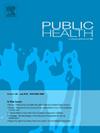家庭生活环境和有组织的课外活动对青少年大麻使用的影响:来自爱尔兰星球青年调查的结果
IF 3.9
3区 医学
Q1 PUBLIC, ENVIRONMENTAL & OCCUPATIONAL HEALTH
引用次数: 0
摘要
目的青少年使用大麻是一个重大的公共卫生问题。本研究旨在调查家庭生活环境和参与课外活动与爱尔兰青少年大麻使用的关系。研究设计横断面研究方法我们分析了“2020年青年星球”调查的数据,这是一份针对爱尔兰西部学龄青少年的匿名问卷。纳入了具有完整年龄、性别和大麻使用相关数据的青少年(n = 4897)。多项逻辑回归研究了与12个月以上、过去12个月(但不包括30天)和前一个月(与从未使用过相比)使用大麻相关的因素。感兴趣的暴露变量包括与家庭生活环境相关的因素(父母的规则设置,父母的监督,前一周午夜后在外面,代际封闭),以及青少年参与课外活动(体育,艺术,志愿服务和/或课外俱乐部)。结果总体而言,908名(18.5%)青少年报告有大麻使用史。具体来说,182人(3.7%)在一年多前使用过大麻,361人(7.4%)在去年(但不是30天)使用过大麻,而365人(7.5%)在过去一个月内使用过大麻。在前一周的午夜之后在户外,缺乏父母的规则设定,父母的监督,代际封闭,缺乏参与体育或志愿活动,都与青少年使用大麻的几率增加有关。结论大麻在爱尔兰青少年中使用较为普遍。在家庭和更广泛的社区中,与大麻使用有关的社会环境因素可能为基层一级可行的初级预防干预措施提供宝贵的见解。本文章由计算机程序翻译,如有差异,请以英文原文为准。
The impact of the home life environment and organised extracurricular activities on adolescent cannabis use: Findings from the Irish Planet Youth Survey
Objectives
Adolescent cannabis use is a significant public health concern. This study aimed to investigate how the home life environment and involvement in extracurricular activities correlate with teenage cannabis use in Ireland.
Study design
Cross-sectional study
Methods
We analysed data from the Planet Youth 2020 survey, an anonymous questionnaire among school-going adolescents in the West of Ireland. Adolescents with complete data pertaining to age, gender, and cannabis use were included (n = 4897). Multinomial logistic regression examined factors associated with cannabis use more than 12 months ago, within the previous 12 months (but not 30 days), and within the previous month (vs. never used). Exposure variables of interest included factors related to the home life environment (parental rule-setting, parental monitoring, being outside after midnight in the previous week, and intergenerational closure), and adolescent involvement in extracurricular activities (sports, arts, volunteering, and/or afterschool clubs).
Results
Overall, 908 (18.5 %) adolescents reported previous cannabis use. Specifically, 182 (3.7 %) had used cannabis more than a year ago, 361 (7.4 %) had used cannabis within the last year (but not 30 days), while 365 (7.5 %) had used cannabis within the past month. Being outside after midnight in the previous week, a lack of parental rule-setting, parental monitoring, intergenerational closure, and lack of participation in sports or volunteering were all associated with increased odds of adolescent cannabis use.
Conclusion
Cannabis use is relatively common among adolescents in Ireland. Social environment factors related to cannabis use, both within the home and in the wider community, may provide valuable insights for actionable primary prevention interventions at the grassroots level.
求助全文
通过发布文献求助,成功后即可免费获取论文全文。
去求助
来源期刊

Public Health
医学-公共卫生、环境卫生与职业卫生
CiteScore
7.60
自引率
0.00%
发文量
280
审稿时长
37 days
期刊介绍:
Public Health is an international, multidisciplinary peer-reviewed journal. It publishes original papers, reviews and short reports on all aspects of the science, philosophy, and practice of public health.
 求助内容:
求助内容: 应助结果提醒方式:
应助结果提醒方式:


